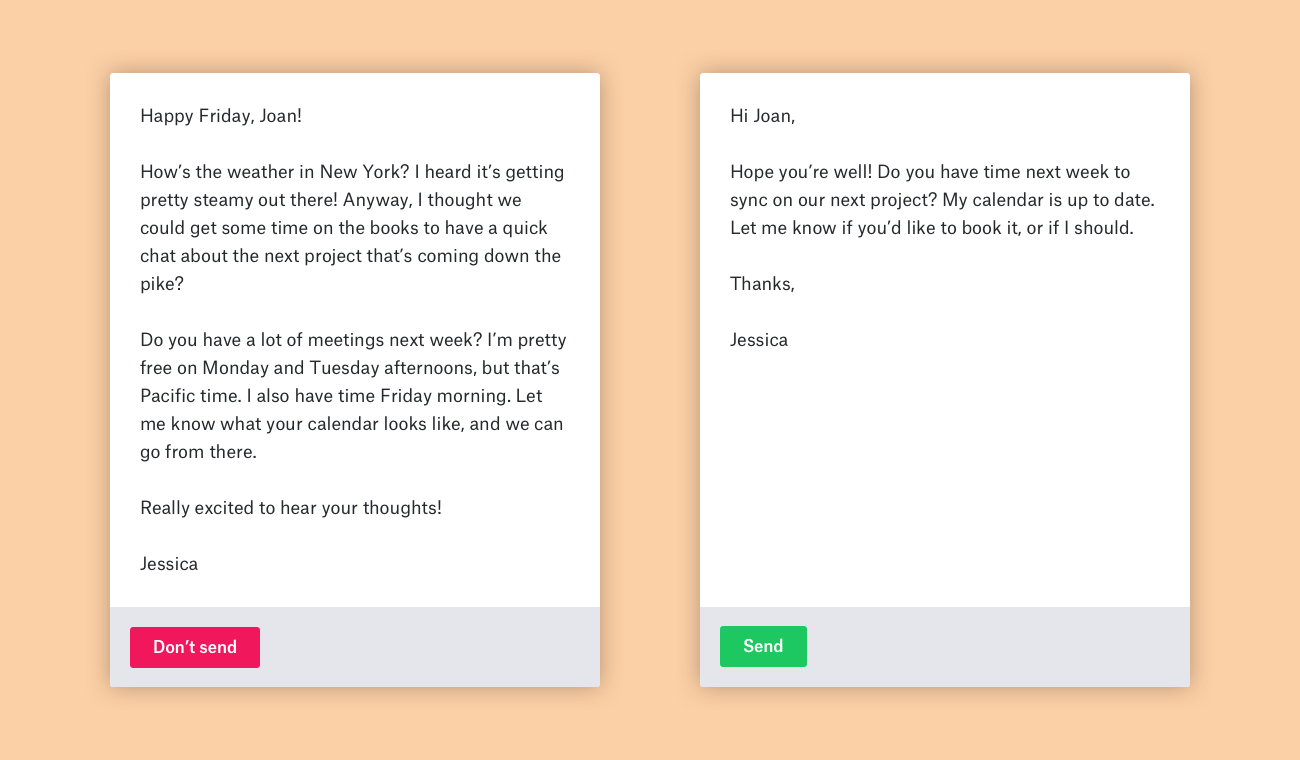
When you need to talk to someone at work, how do you reach them? If you head straight for email or chat, you aren’t alone: A recent report shows that employees at businesses worldwide send and receive an average of 122 emails per day. A similar study showed that the use of chat applications inside businesses is growing quickly as well. And while these technologies enhance our communications in a lot of ways—we can send huge attachments, and chat across time zones—they can create problems, too. With email and chat we miss out on a lot of important aspects of human interaction, like body language, facial expressions, and tone of voice. So it’s worth spending some extra time making sure the things you have to say are easy to understand, and building you a reputation as a good communicator. Here are some tips on crafting the perfect message for whatever you’re trying to accomplish.
The basics: emails and chat
We spend so much of our workdays in email and chat, sometimes it feels like there’s no time to get anything else done. One of the easiest ways to tackle this problem is by making sure the emails you send are as effective as possible. That way, you can get more done with fewer messages—and help others do the same. Keep it short If we’re all handling an average of 122 emails per day, that’s a lot of time we’re spending in our inboxes. So if you can make your message concise and actionable, yet still friendly, your recipients will thank you. It takes a practice to write emails like this, but give it a shot. You may find a lot of extra words, digressions, and turns of phrase that can be eliminated, making your message easier to deal with. Here’s an example:

These tips apply to chat, too. Have you ever been totally focused, only be interrupted by a chat that’s longer than a New York Times article? If so, you know how it can derail your concentration. Avoid doing that to others by sending a clear, succinct chat. The less time your recipient has to spend figuring out what you need, the more likely they’ll be to respond—and pay attention to your messages in the future. Unless longer is better Some messages need to be a little meatier for the sake of establishing and maintaining relationships. If you’re communicating with someone you’ve just met, and want to make a good impression on, it’s okay to ditch brevity in the name of connection. A well thought-out email with a clear beginning, middle, and end can help people get to know you better.
Advanced techniques: collaboration and feedback
Important communication isn’t limited to chat and email; a lot of us are using cloud-based tools to leave feedback on people’s work, or even make changes directly. Like IMs and email, these messages lack the cues of in-person communication, but the stakes can be even higher here. Say what you mean Small comment boxes encourage us to be brief—but when you’re leaving feedback on someone’s work, you don’t want your brevity to be confused for curtness. The urge to simply point out what’s wrong and move on can be powerful. But in order for your feedback to be well received, it needs to be explained in the context of the project. Instead of demanding changes and hitting send, take the time to explain not only how, but why you think something could be improved. For example, if you want to say, “Delete this paragraph,” consider going a bit deeper: “This is almost perfect. I think we can safely combine the strongest points of this paragraph into the preceding one, and tighten everything up.” When you take the time to write your feedback this way, it shows that you’re knowledgeable about the project, and establishes your credibility as a giver of feedback. But say it nicely Sometimes things get heated, and the opinions we’re itching to express are too negative to be constructive. Because our brains are hardwired to receive criticism as a threat, using assertive language can shut down a useful exchange before it even gets going. If you’re agitated and tempted to leave strongly worded feedback, consider waiting until you’ve cooled down. Here’s why: When a co-worker does something you that upsets you, the odds are good that you aren’t getting the entire story. So an aggressive reaction—especially one that’s unfounded—could lead to more problems instead of a solution. Instead, try to trust that your colleagues are doing the best work they can, just like you are, and compose your feedback with that in mind. It’s hard to argue with the benefits of virtual communication at work. We can reach more people, more efficiently, than ever before. There are challenges, though: When you communicate online, you lose critical cues that guide our interpersonal behavior. But by taking the time to create thoughtful communications, you’ll get things done faster, and create trusting relationships with your colleagues. For even more ideas on how to reach peak productivity at work, check out some of our newest Dropbox features.







